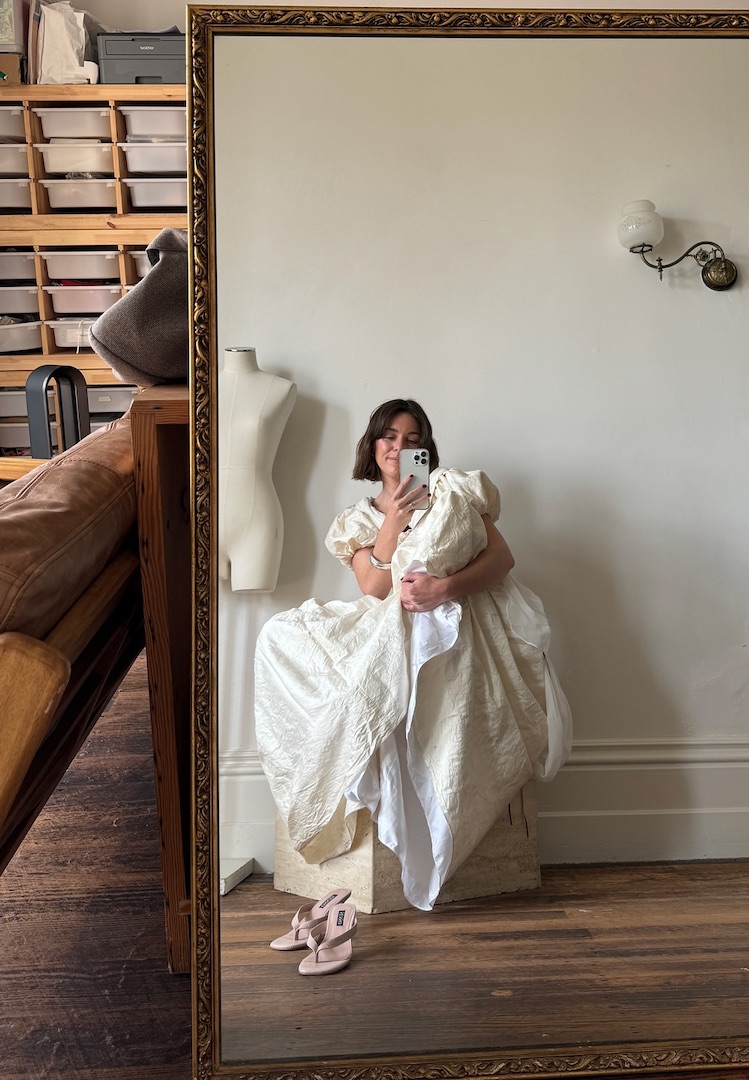How to price your wardrobe to sell, according to three experts
IN PARTNERSHIP WITH EBAY
PHOTOGRAPHER – CATHY MARSHALL
STYLIST – MOLLY JOHNSTONE
MAKEUP – MEG McCONVILLE
MODEL – EMMA @ PEOPLE AGENCY
WORDS BY JULIETTE SALOM
“If you’re a lover of clothes, you want them to be out in the world, not buried in your wardrobe.”
In the thriving world of re-commerce, there’s never been a better time to embrace the circular fashion economy. Resale platforms like eBay offer a seamless way to transform a wardrobe full of pre-loved clothes into a bank account full of cash.
But determining how to price the pieces in your closet is crucial to ensuring they find their way to a new home. We’ve consulted three fashion industry experts for their two cents on pricing items so that they sell quickly and efficiently. After all, less hassle means more hustle in the fast-paced world of fashion resale.
Change with the seasons
Before you begin listing your items, consider the season you’re currently in and the season you’re heading into. This means factoring in both the weather that buyers are looking to build their wardrobes around, and also the fashion calendar that dictates when retailers put their stock on sale.
Fashion stylist and founder of Australian Style Institute, Lauren Di Bartolo, suggests that it’s best to start selling early in the season. “Don’t wait until the market is saturated with countless similar items,” she says. If you want an item to sell fast – and don’t we all – try to anticipate what the market will be looking for.
If you’ve missed the chance to list an item and it’s already mid-season, eBay seller Millie Romanin says that patience is key. “Hold onto things,” she says. “I just recently sold one of my cardigans. If I’d listed that over summer, I wouldn’t have gotten a good price, whereas I got close to retail [price] selling it [at the start of winter] because everyone starts to get cold.” So hang onto that cosy Aje puffer, that Scanlan Theodore coat or those vintage Tommy Hilfiger shorts – the right season will come for them to be listed soon enough.
Anne-Marie Cheney, Fashion Lead at eBay Australia, adds that good things (high sales) come to those who wait. “It’s quite hard to list items around a heavy sale time because there are so many sales going on!” she says. “If it is a really good brand and it’s in a really good condition, you might be best just to wait for a little while.”
Style it like you mean it
An expert in how human behavioural thinking and fashion styling intersect, Lauren points out that prioritising how you style your pieces in the pictures on your listing can lead to quicker sales (and at higher price points). “We’re in a time where people are looking for singular items that create cohesive looks. If the shoe fits the look – or the top, skirt, etc – a buyer will consider a purchase,” she says.
“You would probably want to see it… on a hanger, a close-up shot of the fabric and any imperfections or damages (remember this won’t turn people off if they want the item enough!) and the colour in true [natural] light. The flash on your phone during a late-night wardrobe makeover isn’t going to cut it,” she adds.
Set your minimum selling price
When you’re coming up with a price for your listing, it’s best to consider the absolute minimum amount that you’d accept to part with the item. “Don’t be too hung up on what you paid for it,” Anne-Marie suggests. If you’ve got an item sitting lonely in your wardrobe, any dollar you make from it is worthwhile. Lauren agrees. “Establish the minimum price you’re willing to sell the item for, knowing anything above that is a bonus,” she says.
On eBay, the platform’s low selling fees mean you can keep more of your hard-earned returns. There’s also a variety of easy and secure shipping options to choose from, meaning that you have more time to devote to selling over shipping. With shipping options like Sendle, the process is made hassle-free with printer-free pickup right from your doorstep. No more last-minute post office runs and you don’t even need to print a label. Just write the address and the code on the parcel.
Research pays off
Knowing both the market you’re selling in and the one that consumers are buying in is vital in determining the price of your items on eBay. As a starting point, Lauren suggests browsing similar garments being sold on the platform. “Look at what other items in the category are selling for, to get a baseline,” she says. “Basing a price on what you purchased it for [from a retailer] isn’t as reliable as current market demand.
Anne-Marie tells me that immersing yourself in the fashion world is also another great way to know what buyers are looking for. This might mean absorbing fashion media (hello FJ!), following fashion accounts on Instagram or keeping up to date with trending brands. “Be mindful of the trends that are coming in,” she says. TikTok can be your best friend when understanding what micro trends are dropping. Use that knowledge to optimise your listing – talk to that trend and tell the buyer why you think the item that you’re selling fits in with that particular trend.
Understanding which labels and styles are hot property might mean that you can price a piece slightly higher than usual, Anne-Marie adds. “Also have a look at what that item might have sold for on eBay previously, and you can use our price guidance tools [like the pricing indicator] to be able to do that,” she says.
What’s the condition?
Considering the condition of the pieces you’re listing on eBay will help you, and the buyer, determine the fairest price. The number one thing to remember when you’re selling pre-loved garments is honesty is the best policy. Shoppers may not mind if the condition isn’t perfect or if an item is well worn – that’s the magic of the pre-loved economy. Making this clear in your photos and descriptions is key in pricing your clothes accordingly.
Lauren says the condition of an item affects not only the price but also the way that it can be styled. “A garment in good condition is always easier to style and sell, which is even more reason to look at the garment care tags. If a garment isn’t in its perfect condition, the resale price will be affected, so as a seller, we need to be mindful.”
While an item in a “true pristine condition” can attract a premium price, according to Anne-Marie, this shouldn’t deter you from listing your pre-loved goods, no matter the condition. “I definitely don’t think you need to go to the effort of repairing items for resale,” she says. “I think that you can just call it out and be really clear in your communication and take a picture of where the repair might need to be.
“You could also then mention it in your listing description, like, ‘You could get this repaired for $5 at a boot repair shop’, that sort of thing. People that are buying in the secondary market are open to doing that themselves.” Ultimately, Anne-Marie says, “Be honest and upfront, and then price it accordingly.”
Someone else’s treasure
Anyone who loves fashion knows the cherished sentiment that can be attached to our wardrobe. When it comes to reselling your pre-loved threads, it’s important to disentangle the relationship between your items and the emotive value you place on them. To put it simply, Anne-Marie suggests to “take the emotion out of setting the selling price.”
“Reframe it to yourself: if it’s sitting in your wardrobe and it’s unloved right now, give it to somebody who will really love it and give it its second life. I think that if you’re a lover of clothes, you want them to be out in the world, not buried in your wardrobe. If you then can make some additional money off that, particularly at the moment where everyone’s feeling the pressures around the cost of living, [money] back in your wardrobe or back in your pocket is actually better than [nothing].”
Be realistic
eBay seller Millie’s best advice is to remain realistic about what it is you’re selling. After taking the emotion out and considering an item’s condition, be honest with yourself about what someone might pay for it. It’s the perfect mindset that will help you sell fast and sell more, ultimately keeping the cash flowing in. “I would tell people to be realistic about it being pre-loved,” she says. “[The pre-loved economy] is a different currency.”
As a seller who’s constantly churning through stock on eBay, Millie admits that she’s personally quite impatient when it comes to selling items. “I often mark things down by quite a bit just to try and clear it,” she says. “But I’ll justify it by a cost per wear. If I’m knocking off a hundred dollars and I’ve worn the dress a couple of times, that to me is a win.”
What to do when items don’t sell
There’s a range of different factors as to why an item won’t sell right away, but don’t let that discourage you. eBay makes it easy to relist an item, with automatic relisting once the sale period comes to an end. “You don’t even really need to think about it,” Anne-Marie says. “eBay will just do that work for you.”
If you still find that your listings aren’t getting any bites, Anne-Marie suggests potentially lowering the price. “Also, have a look at what else is for sale from that brand, and have a look at how your priced item stacks up against the competition of other people.” Alternatively, Anne-Marie adds, “If you’ve done an auction, maybe change it to a ‘Buy It Now’ and bring the price down. Or the opposite, if you’ve done ‘Buy It Now’, maybe change it to an auction and see if you price it at a lower point and people start bidding against each other. You might be able to bring the price up that way.”
Ultimately, practice patience until you can’t wait any longer for an item to be gone, and then consider adjusting the price to a figure that would just be too good for a buyer to pass up. At the end of the day, no matter what price you sell an item for, you’re making easy cash to invest right back in your own wardrobe.
To rehome your own pre-loved gems, head to eBay.













